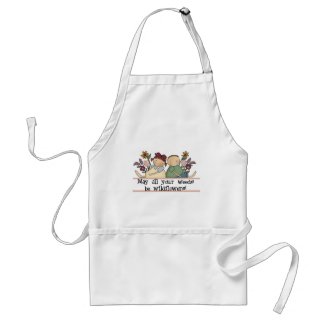
Every year after the rains, the weeds become lush and everybody but me around here starts thinking about chemical weed abatement. That's why I intend to give the men a quick botany lesson in the field so they can identify the real weeds.
I prefer to pull the weeds by hand as I have time, since it provides good exercise and lots of material for the compost heap (except for poisonous plants). When the men around here see weeds, they automatically think about Round-up and mechanical sprayers. I make one concession -- the path to the garden -- since I do have to get out there and be able to get the gate open. Other than that, it's a race to see who gets to the fields first -- me or my weed abatement man or husband.
John, our weed abatement man, bless his heart, doesn't seem to know what a wildflower is -- or for that matter, an herb or flower not yet in bloom. They are all weeds to him. He has two ways to deal with what he perceives are weeds -- the sprayer and the tractor. A couple of years ago I made rock borders around my garden areas and told him to leave them alone, since he sprayed my sage that year and I made him wash it off before it was too late. He sprays first and I notice him when he's about half through. It may be a race again this year, since the tall grasses have overgrown and covered up the rock borders. When we pruned and cut branches from the fruit trees last month, I dragged the large branches to border the area where I seeded the poppies so that John would not be able to easily get the tractor through before I could notice him.
So that left Hubby to instruct. He, at least, did appreciate the beauty of the poppy field last year, so he's willing to be dragged out to learn to tell the difference between flowers and weeds. I took him to the herb garden, almost completely overgrown, to show him what a California poppy looks like. He confessed to having sprayed some along the garden path. I showed him that Poison Hemlock, which I want him to spray, is different. I also tried to teach him the difference between wild mustard and Flanders Poppies, and what lupine looks like before it blooms.
 |
| California Poppy Plants Not Yet in Bloom, © B. Radisavljevic |
Just above are California poppy plants which will bloom soon. Below is poison hemlock, which smells sickeningly sweet if you pull it, and which will get to be six feet tall if you don't.
 |
| Poison Hemlock Seedlings, © B. Radisavljevic |
Below is a Flanders Poppy, beside the black pot. It will have lovely red flowers. There is a photo of a Flanders poppy in bloom in my Memorial Day post. Below it is wild mustard, which will grow to six feet in good soil and will send its roots deep.
 |
| Flanders Poppy Seedling beside the Black Pot, © B. Radisavljevic |
 |
| Young Wild Mustard, © B. Radisavljevic |
 |
| Young Lupine before Blooming, © B. Radisavljevic |
To the left is lupine, growing up and getting ready to bloom. I collect seed from the poppies and lupine each year, but I also let a number of them reseed.
 |
| Herb Garden in Early Spring, © B. Radisavljevic |
I am looking forward to another field of poppies this year. It should appear in the herb garden (above), in front of the two tall shrubs (butterfly bush and sage), where you can already see their green tops, and for a long way behind them. The poppies are also growing all around the patch of ground above, so it ought to be a great view from my kitchen window later on. Meanwhile, I need to work on all those weeds that are trying to swallow the herbs, irises, and daffodils. Today I also planted some Lilies of the Nile in this bed this morning, but they are too small to see. How I love spring!
For more on important weeds you need to pull in early spring, see my more recent post on California Weeds You Need to Pull Now.


No comments:
Post a Comment